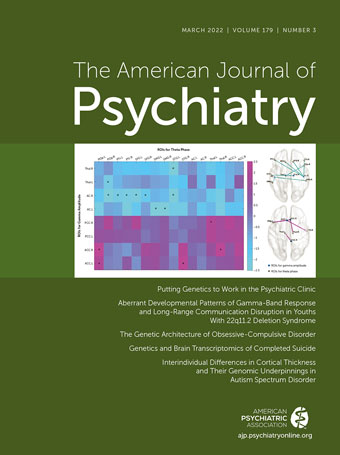Since the pioneering work of Åsberg et al. (
1), method of suicide attempt has been often used in suicide research to stratify individuals in two subgroups: those using nonviolent methods, which do not involve the infliction of bodily harm, such as drug overdose, and those using violent methods, which involve methods that cause bodily harm, such as hanging, immolation, and the use of a firearm. Studies investigating neurobiological processes associated with suicidal behavior have shown, for instance, that individuals who use violent methods have lower indices of serotonergic neurotransmission (
1–
4). However, differences associated with suicide method may, in part, be explained by other factors. For instance, sex, age, and personality traits, particularly impulsive-aggressive traits, are strongly associated with violent suicide methods (
5–
9). Importantly, most of the studies examining neurobiological correlates of suicide method have focused on individuals who attempted suicide but did not die by suicide (
1,
4). Consequently, our understanding of the validity of this classification among individuals who died by suicide is limited, and whether or not individuals who died by suicide using violent methods present different neurobiological alterations remains a question of significant interest.
In this issue of the
Journal, the study by Punzi and colleagues (
10) advances our understanding of the molecular basis of violent suicide. The authors analyzed global patterns of gene expression in the dorsolateral prefrontal cortex (DLPFC) of suicide decedents who used violent and nonviolent means, as well as of neurotypical control subjects. An additional group of psychiatric subjects who did not die by suicide was also included. Suicidal behavior aggregates in families, independent of the transmission of high-risk psychiatric illnesses (
11,
12). Hence, the biological underpinnings of suicide may be distinct from the psychiatric illnesses that increase suicide risk. The inclusion of this additional group allowed for the detection of molecular alterations that were specific to suicide, independent of underlying psychopathology.
Interestingly, violent suicides showed a transcriptomic pattern that was not only divergent from psychiatric subjects who did not die by suicide but also from those who died by suicide using nonviolent methods. In both comparisons, violent suicides showed up-regulated expression of genes involved in G protein-coupled purinergic nucleotide receptor signaling. Across all comparisons, the most dramatic differences were observed between nonviolent and violent suicides. However, few genes were differentially expressed between violent suicides and control subjects. Additionally, psychiatric subjects who did not die by suicide were more similar to nonviolent than violent suicides. Of note, when subjects were stratified by sex, differential expression by violent suicide appeared to be driven by the male subsample. However, given the underrepresentation of female subjects in the study, it is difficult to conclude whether these results are sex specific. Nonetheless, the authors’ findings suggest the intriguing possibility that violent and nonviolent suicide “represent opposite tails of a potential continuum of gene expression in the DLPFC.” To test this hypothesis more directly, the authors modeled a linear relationship between gene expression and an ordinal scale for group. This analysis revealed 936 genes that were significantly associated with the scale from nonviolent to violent suicide. There was once again an enrichment of genes involved in G protein-coupled purinergic nucleotide receptor signaling among those that showed a linear increase in expression with group.
To gain further insight into biological processes underlying violent suicide, the authors turned to weighted gene co-expression analysis. Using this approach, they searched for modules that were specifically associated with violent suicide. This analysis revealed a module that was enriched in genes involved in synaptic transmission and GABA synthesis. However, when looking at a module that showed the greatest enrichment of genes that were differentially expressed by violent suicide, purinergic signaling once again emerged. Within this module, four purinergic receptor genes showed evidence of being highly connected hub genes. Interestingly, two of these genes (
P2RY12 and
P2RY13) have been shown to be enriched in microglia (
13). A future cell-type-specific approach may therefore be warranted to elucidate the mechanistic link between microglia and violent suicide.
Given the association between violent suicide and impulsive-aggressive behavior (
5), the authors turned to two genome-wide association study data sets of aggressive behavior in
Drosophila melanogaster. Similar to violent suicides, there was an enrichment of purinergic system genes among those that were associated with aggressive behavior. Future work should investigate whether purinergic signaling relates to aggressive behavior in other, evolutionarily closer, species. However, these new data do present the possibility that the link between violent suicide and aggression may be mediated through purinergic signaling.
In order to determine whether violent suicide is distinct on a genomic level, the authors analyzed genomic risk scores (GRSs; also known as polygenic risk scores) for each of the psychiatric illnesses represented in the study, as well as other traits associated with suicide. These analyses revealed that the polygenic risk profile in violent suicides was relatively low for each psychiatric illness, as well as for suicide attempt. For instance, violent suicides showed a trend toward higher GRS for schizophrenia resilience compared with nonviolent suicides. Similarly, GRSs for IQ were also more similar between violent suicides and control subjects than between violent suicides and other groups. Overall, the results of the authors’ GRS analyses mirror their transcriptomic findings and suggest that individuals who die by violent suicide are molecularly divergent from those who die using nonviolent methods.
Altogether, the results of this study lend credence to the idea that violent and nonviolent suicide present distinct neurobiological underpinnings. This work has important implications for future postmortem studies of suicide. Stratifying subjects by method of death may not only help to reduce some of the heterogeneity implicit to suicide but also advance our understanding of the molecular biology. Given the unequal representation of female subjects in this study, as well as the fact that women tend to use nonviolent suicide methods, future studies should investigate whether neurobiological differences between violent and nonviolent suicide are also valid in females.

